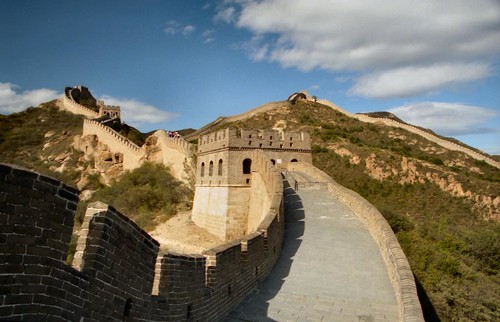
Picture of Jantar Mantar
Photo by: mckaysavage, Creative Commons
The Jantar Mantar is an observatory located in Jaipur City, state of Rajasthan, India.
The Jantar Mantar was built by Jai Singh II (emperor of the Amber dynasty) in between the years 1727 and 1734. There are a total of five Jantar Mantar observatories of the same style built by the emperor at different places. Among the five constructions, the Jantar Mantar observatory at Jaipur is considered as the biggest of the five. In the year 1948, the Jantar Mantar observatory was stated as the National Monument.
The name “Yantra” actual word Jantar means “an instrument” and “Mantra” means “principle”, the people of Rajasthan pronounce the word “Ya” in place of “Ja”.
The Jantar Mantar was built with marble, several stones and bronze sheets; the placement of these materials is very accurate. The Jantar Mantar observatory is also known as “time machine”. It contains 14 numerical devices which are used in time measurement, approaching eclipses, discovering new planets, present condition of the planets and predicting about the outer space altitudes.
Among the devices inside the Jantar Mantar, the biggest instrument is the “Samrat Jantar”, which is about 90 feet high and faced at 27 degree latitudes to Jaipur city. The Shadow of Samrat Mantar is plotted in such a way that the time can be calculated based on the instrument. The Samrat Yantra (sundial) is also the world’s biggest sundial which calculates the accurate time of Jaipur city every two seconds. In addition there is a small dome on the top of the Samrat Jantar which predicts the seasons and eclipses.
In the present days, the Jantar Mantar observatory is a great tourist spot, the people of this city still use the Jantar Mantar for the prediction of weathers. The Jantar Mantar is also filmed in many national and international films and has become a great spot for shooting films.
Traveling to Jantar Mantar observatory
The Jantar Mantar opens at 9:00am in the morning and closes 4:30pm in the evening.
Jaipur being the capital city of Rajasthan state and also second largest tourist spot in India is well connected with all the parts of the country. In addition there are several bus services from all the parts of Rajasthan state. People traveling there can choose their means of transport according to their interest.





















































![[TWS2008] Great Wall of China by scion_cho.](http://farm3.static.flickr.com/2207/2467113574_7c78c61ac6.jpg)